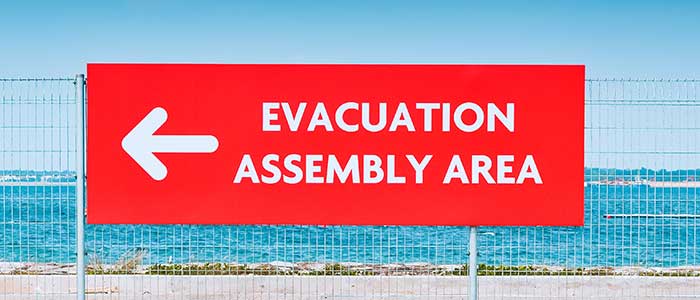Dashpivot article – OSHA Emergency Action Plan Sample
OSHA Emergency Action Plan Sample
Scroll down to see an OSHA Emergency Action Plan sample, as well as a lot of other context you can use to improve your emergency action planning.

In the case of certain workplace crises, an emergency action plan is a formal document that offers a thorough description of the protocols and processes that must be followed, which we'll cover below. In any industry, there is always a chance that an emergency will arise. It is crucial that corporations and groups assume responsibility for planning events of this kind.
The emergency action plan is one of the most important documents for emergency planning. Numerous risks can be decreased, and many lives can be saved when a thorough emergency response plan is in place.
You can read more about OSHAs Emergency Action Plan Requirements here.
Key components of an OSHA EAP
Before we jump into the OSHA emergency action plan sample below, we'll outline the key components of any emergency action plan, inline with OSHA and the vast majority of safety requirements.
Emergency Protocols
This is a comprehensive instruction for each and every conceivable emergency that might occur in a certain industry. In order to properly give people with awareness, the procedures should offer personnel complete information about what to do from the beginning of the disaster.
One of the steps that should be included in the protocol is the list of emergency contact numbers. Because of this, help will be easily accessible, and the response time will be sped up. Detailed information on emergency routes has to be included in the emergency protocols. A safe and secure evacuation will be made easier as a result of this.
In addition, the emergency protocols should include a section on the processes that must be followed after an incident has occurred, such as doing headcount and determining whether or not there are any injuries.
Forming A Dedicated Emergency Response Team
It would be more successful to rescue individuals if there was a committed and trained crew to respond to the various situations that may arise. It is crucial to remember that members of these teams must possess the necessary education and certified abilities to treat, remove, and rescue victims using the proper methods and protocols. Here are the teams that you should form in your organisation:
- First Aid Team: This is a team dedicated to responding to personnel who are injured in an emergency. The personnel involved in this team should have the required knowledge in bandaging, fracture immobilisation, and treating burns. In short, they are the primary carers before help arrives in the area.
- Search and Rescue Team: This team is specialised in systematic searches in different environments. They are equipped with tracking techniques and well-versed in tools like drones and search dogs to look for trapped and missing individuals. These are useful in emergency settings like building collapse or confined spaces.
- Fire Fighting Team: This will be the team who will be handling fire emergencies. They are experts when it comes to firefighting methods, especially when talking about classes of fire extinguishers. They will be the first to respond if ever a fire occurs in the work environment while waiting for the area's fire department to arrive.
Seminars, Trainings, and Drills
All employees should participate in seminars, trainings, and exercises in order to completely execute the emergency response plan. Employees will be able to learn about the emergency procedures set up by the company and organisation through seminars and trainings. This will make them more prepared in the event of an emergency. Conversely, drills improve readiness and reaction times.
Employees will feel more confident about what to do in a real emergency thanks to this. In a real emergency situation, all of these will facilitate cooperation and communication, which lowers the number of fatalities and injuries.
Audits
Following each exercise or disaster, an audit of the emergency response plan must to be carried out. This will assist in locating any holes in the present processes and then offering suitable solutions to fill them.
Additionally, since we might not be aware that the next catastrophe is imminent, these audits should, if at all feasible, be completed promptly.
OSHA Emergency Action Plan (EAP) Sample

Use and customise this Emergency Action Plan Sample for free
Disasters and Emergencies You Should be Considering in Your Emergency Action Plan/s
Let us now examine where emergencies normally arise from.
It is critical to study this subject first in order to completely grasp the crucial aspects in developing an emergency action plan. Disasters are frequently the source of emergency situations. These calamities might be natural or manmade.
Natural Disasters
Mother Nature's harsh forces are inherently present in our world. There is no way to prevent these events, but our great brains have devised methods to foresee and reduce the consequences of some of these natural disasters. Here are some common natural disasters.
Earthquakes
The tectonic plates of the earth are always moving and changing, which leads to the plates grinding against one another. The fault lines become very stressed as a result, and when the plates are unable to bear the strain, they release energy in the form of seismic waves, which causes an earthquake. These energy releases are sometimes so strong that they could topple buildings from the shaking.
Typhoons and Tornadoes
Typhoons develop in the warm ocean waters. They occur because warm ocean waters heat up and moisten the air, which then interacts with cool, drier air, thus creating a low-pressure area where winds begin to swirl around. Tornadoes, on the other hand, are mostly formed during thunderstorms. Warm, humid air rises while chilly air descends with rain or hail inside thunderclouds. Inside the cloud, these circumstances may result in rotating air currents. Even though the spinning currents begin horizontally, they have the potential to become vertical and descend from the cloud, forming a tornado. Both of these phenomena can carry destructive winds that can potentially do significant damage to homes and buildings.
Wildfires
A wildfire is an uncontrolled fire that starts in wildland vegetation, usually in rural locations.They are not restricted to one continent or habitat.Wildfires can begin with a natural occurrence, such as a lightning strike, or with a human-caused spark. However, meteorological factors frequently dictate how quickly a wildfire spreads. Wind, high temperatures, and little rainfall may all dry out trees, bushes, fallen leaves, and branches, making them ideal fuel for a fire. Wildfires near towns may become dangerous, even fatal, if they spread uncontrollably.
Volcanic Eruptions
Heat moving under the Earth's surface causes volcanoes to explode. They usually start when gas-rich magma (molten rock) builds up in pools close to the Earth's surface. However, small cracks in the ground may release steam and gas before they happen. Small earthquakes, which can be caused by a rising plug of dense, viscous magma moving back and forth between a sheath of less dense, more accessible magma, can also be a sign of volcanic outbursts, especially powerful ones.Volcanic events can destroy a lot of property and kill a lot of people. They range from explosions that aren't too bad to ones that do a lot of damage.
Man-made Disasters
Man-made disasters typically result from human negligence and a failure to adhere to established systems. In an industrial setting, these are usually hazards that were not provided with the appropriate and sufficient measures. Here are some industrial man-made disasters that commonly take place around the world.
Industrial Fires
These are fires that occur in an industrial setting. They happen in warehouses, manufacturing plants, chemical plants, and power plants. There are a lot of causes of industrial fires, but most of them came from unidentified hazards, negligence, and not following safety protocols. This disaster can affect operational machinery, harm or kill employees, and impact business productivity.
Oil Spills
We use oil, an old fossil fuel, to heat our homes, make electricity, and power big parts of our industry. But oil that gets into the ocean by mistake can cause a lot of trouble. Oils have the potential to destroy an ocean's ecology, which might lead to the demise of many marine species.
Structural Failure
The weight capacity of a structure reduces as the structural integrity of the building is compromised. Whenever the strength of a material is surpassed, the substance begins to bend or break. This phenomenon is referred to as structural failure. Given that there is a danger of collapse, this might be a potentially fatal circumstance. In addition, there is the possibility of flying debris, passengers and observers being injured, and being trapped.
Operational Failure
This refers to machinery and equipment going haywire. The uncontrollable movements from a malfunctioning machine have many hazards. One of the hazards associated with this is crushing hazards, which can trap, squeeze, and crush body parts. Another one would be flying parts, where high-pressure releases can eject a heavy object from the machine and hit nearby employees.
Identifying Sources of Possible Emergencies the Smart Way
The best way to make an emergency action plan is to identify sources of possible emergencies as soon as possible. To do this, companies and organisations should conduct regular inspections. However, manually conducting these inspections with pen and paper could be time-consuming, thereby defeating the goal of identifying these sources as soon as possible.
Fortunately, with Dashpivot, streamlining your inspections is now easier.
All your inspection forms and documents can be stored in a single document library, and you can create custom forms using a drag-and-drop builder. This will convert your existing Word, Excel, or PDF forms into the digital format, or you can choose from our library of hundreds of free forms to get started right away. This will provide your inspectors with the tool to start their work right away. With Dashpivot, it is also possible to obtain real-time information regarding performance and inspections.
You will be able to correctly monitor what is taking place thanks to Dashpivot's ability to automatically extract the data that is being gathered on site into individualised dashboards and visualisations. Obtain specific information on the number of inspections that have been carried out, the individuals who carried them out, and the results of those inspections. This will allow you to make more informed judgements regarding what actions to take going forward.

Safety improvement plan
Use this framework to outline and update your safety processes

Operational readiness form
Ensure your operations are compliant and up-to-date.

OSHA incident report form
Streamline how you report incidents inline with OSHA

